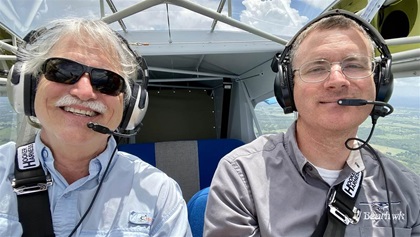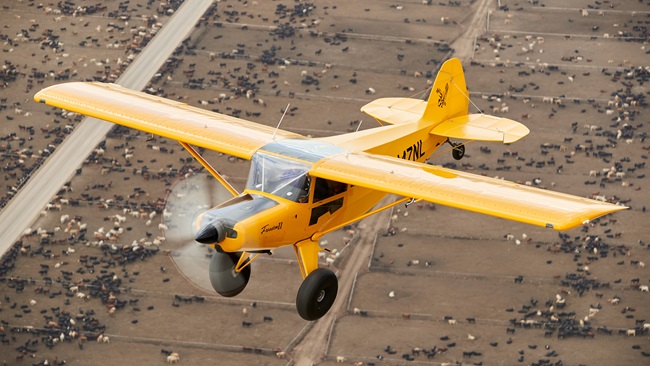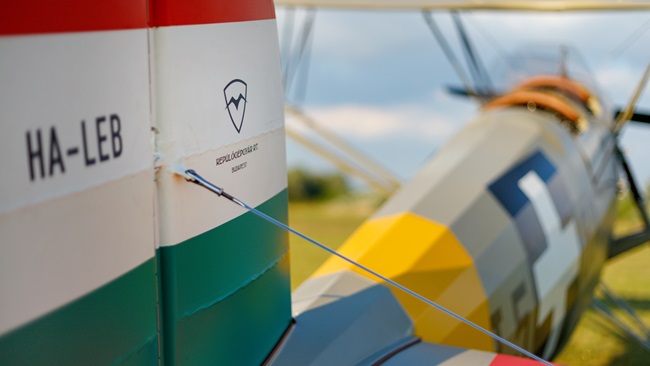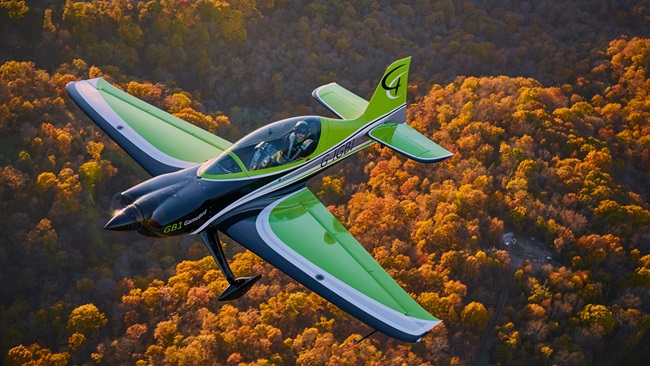Capable homebuilt performer
STOL model can be constructed for around $100,000
Bearhawk




During college, the international studies major became infatuated with the area near the Popocatépetl volcano, a three-hour drive southeast of Mexico City. He was impressed with the natural beauty of the highlands, the climate, and the colonial architecture in the state known for introducing the world to mole, the chocolate-based sauce made from poblano peppers.
He purchased property for a home here, and during the ensuing five decades Goldberg visited frequently, participated in family milestones, and considered them his relatives. “They’re more like family than my family,” he said. Goldberg named his son, Michael Agustin, for the patriarch, Agustin Limon.
He recalled that during visits to the area, “the gravely runway tore up the airplane” that he had meticulously completed with Limon’s son, Angel, in 1998.
He was appalled at the damage. This won’t do, thought Goldberg. He decided that he needed an aircraft more suited to the rustic environment. While others were pursuing what he calls the “go-fast airplanes” of the late 1990s and early 2000s, he turned his attention to the converse—a little-known but very capable plans-built four-seat backcountry short-takeoff-and-landing (STOL) high-wing called the Bearhawk Aircraft 4-Place that he found after doing research in 2000. As a plans-built airplane, the Bearhawk 4-Place remained an undiscovered gem until Goldberg approached designer Bob Barrows about producing a quick-build kit. Goldberg fashioned a factory in his home-away-from-home and instructed his adopted family how to build, run, and supervise an aircraft manufacturing facility in Mexico.
The aircraft, which is simply known as “the Bearhawk” even though it’s the flagship for derivatives spanning two to six seats, has since proved so popular that orders are backed up for over a year. Goldberg attributes the increased appeal to the availability of the quick-build airplane kits and the parts kits he pioneered in 2001.
About 200 plans- and kit-built Bearhawk 4-Place airplanes are flying in the United States, Brazil, Canada, Australia, New Zealand, and Europe—and more than 1,700 plans have been sold in the past 20 years. Several Bearhawks have accumulated more than 1,000 hours. About 75 percent of the Bearhawks built have six-cylinder Lycoming O-540 engines and about a quarter of them have four-cylinder Lycomings. Goldberg said the advantages of the Bearhawk line, “apart from how good they fly,” is “how ruggedly they’re designed and built. The 4130 steel tubing fuselages are quite stout.” The all-metal, completely flush-riveted wing is designed by “100-percent old-school mechanical engineer Bob Barrows,” said Goldberg, and incorporates a Harry Riblett airfoil, which contributes to docile stall characteristics, gentle slow-speed manners, impressive short field performance, and cruise efficiency. “There’s not a round-head rivet in the breeze” to create parasitic drag, he said.
The 2024 T3 aluminum used is the same material found in certified aircraft from manufacturers including Beechcraft, Cessna, and Piper. Some kit aircraft manufacturers use a cheaper grade of aluminum known as 6061 T6, which Goldberg said cost half as much, but is 40 percent weaker. “So, what it means, is that if you use a cheaper material, you can obviously sell your kits cheaper, but you also don’t have the serious rugged structure like Bob Barrows designs.”
Two oversize cockpit doors make entry and exit easy, and a spacious baggage area opens to an adjacent back-seat door. The rear fuselage accommodates a six-foot loading area. He said the airplane is “larger in every dimension” than a Cessna 172 Skyhawk and compares favorably with utility aircraft including a Maule, a Cessna 180 Skywagon, and a Cessna 182 Skylane.
Details




Barrows’ design
Barrows’ no-frills approach to designing aircraft is well-known to homebuilders. The aluminum wing is more efficient than a fabric wing and has a “good, sturdy design,” Barrows said in an instructional YouTube video. The single-strut wing exhibits good lift, low drag, and low pitching moments, which contribute to higher airspeeds than one expects in a utility category airframe of similar design. The fuselage’s steel tube frame “has much better crashworthiness and is easy to repair if you get into an accident or something. You may even be able to do some field-repair if you’re out in the boondocks and tear up something,” Barrows said.
“Now we’re making five different models, all designed by Bob [Barrows],” Goldberg said. The two-place tandem Patrol followed the original Bearhawk 4-Place as “a great alternative” to the backcountry do-it-all Piper Super Cub. The next Barrows design was the two-place Bearhawk LSA, which Goldberg said “pleasantly surprised” him with its capability. Two other models round out the line: the side-by-side, two-seat Companion, a derivative of the Bearhawk four-seat fuselage mated to Bearhawk Patrol wings “with some modifications”; and the brawny six-seat Model Five, so named because it was Barrows’ fifth airplane design.
The original Bearhawk 4-Place was basically a scratch-built aircraft that appealed to a limited number of craftsmen until Goldberg came along. An import/export career prepared him to suggest to Barrows that they manufacture the aircraft as kits in Mexico using skilled labor from Goldberg’s trusted friends. “I would never go to Mexico and hire strangers” to fabricate the aircraft parts, Goldberg said.
A 7,000-square-foot former coffee roasting facility was converted to an aircraft manufacturing facility in Atlixco. In 2001, Goldberg’s Avipro Fabricantes produced the first kit at the factory near Puebla, Mexico, and he “kept the ball rolling” employing family whom he trusts and respects.
Angel Limon had previously traveled to the United States. and lived in Austin with Goldberg for more than a year while they constructed the Van’s RV–8. Now Angel’s two sons, Agustin and Luis, run the factory in Mexico. “I’ve known the two brothers since they were little kids,” Goldberg said.
The operation is meticulous about quality control, Goldberg said. Custom jigs and factory tooling also ensure consistency. As proof he pointed to glassy smooth, burr-free gas welds at a juncture of seven tubes reminiscent of European racing bicycle quality. When comparing the frame materials and construction techniques to a competitor’s product, “it would immediately be noticeable that our tubing is much beefier,” he said.
The fabricated and corrosion-proofed aluminum wing spars and ribs are finish-riveted and mated to pressure-tested fuel tanks, and then packaged with a fuselage, tail feathers, flaps, and other components, and transported overland to Texas, five per trailer load. From there, they are dispatched to customers worldwide.
Mild-to-wild engine choices from 150 to 260 horsepower have created a cult following for the capable four-seater. Builders have installed a variety of powerplants, from the familiar four-cylinder 180-horsepower Lycoming O-360, up to a six-cylinder Lycoming 260-horsepower O-540 parallel valve engine. “Once you get a taste of that power and get pushed back in your seat when you take off, it’s very impressive, and very exciting,” Goldberg said.
The Bearhawk has a useful load around 1,000 to 1,200 pounds; cruises between 135 and 150 miles per hour; lands at 40 mph; climbs between 1,000 and 2,000 feet per minute; and has a range between 650 and 900 miles, depending on the engine and power setting. Gross weight is 2,700 pounds on wheels and with floats attached.
Bearhawk builder and transition training instructor Jared Yates said the control harmony, stall characteristics, and low speed handling in the 4-Place are “exceptional.” He said a key attribute is that “you’re actually not going to accidentally stall one of these because there are so many warnings. It won’t catch you by surprise.”
Goldberg said the Barrows designs are unusual and especially useful because they “get on and off quite short”—200 to 400 feet at normal takeoff weight—and “also have surprisingly high cruise speeds. You know, Bob’s designs take a lot. They are very rugged. We’ve fixed almost nothing in 2,000 hours except starters and alternators and some assemblies. Bob’s designs are rock solid, and stout as can be.”
Kit Number One
Goldberg said constructing the airplane from a fuselage and advanced-completion wing kit is possible for those short on skills but long on patience. He built the example that he calls “Kit Number One” in about 13 months and affectionately named it El Atlixquense (from Atlixco), a tribute to the city where the factory is located.
“The first one isn’t the prettiest 4-Place but it’s a workhorse,” he said during a visit to the Texas ranch near Austin. Two hangars of airplanes and airplane parts share space with a 2,600-foot-long grass landing strip; pastureland dotted with his five sheep and two grazing cows; and a garden with rows of watermelon, cucumbers, peppers, and tomatoes.
When comparing the frame materials and construction techniques to a competitor’s product, Goldberg said “it would immediately be noticeable that our tubing is much beefier.”Goldberg said that building your own “brand-new airplane that you know inside and out—because you built it—and then taking off and having it fly and it being such a great flying airplane—that’s a tremendous sense of satisfaction.” A typical Bearhawk 4-Place model can be assembled for between $80,000 to $85,000 up to about $115,000, depending on engine and avionics choices, and may be an attractive option when considering a new, similarly equipped certified aircraft that could cost several hundred thousand dollars more.
Building an airplane from the ground up might seem like a daunting task to those who have yet to open a crate of parts and visualize themselves flying a fully assembled aircraft that they built one fastener at a time. Goldberg’s cellphone rings daily with builders asking questions, and he coaches them through the nuances of home-building. Goldberg is keen to encourage others to pursue home-building for the sense of accomplishment and for the knowledge gained learning about every system, fastener, and component. “If you’re willing to ask questions, and not just drill holes before you know what you’re doing, you’ll be fine,” he said. “Most of the people buying our kits have never built an airplane before. It’s awfully fun, and when you’re in the airplane itself, it’s even more thrilling. It’s a satisfaction you don’t really understand until you’ve done it.”
Flying a Bearhawk 4-Place
 I was introduced to the performance of a Lycoming 250-horsepower model by Charlotte, North Carolina-based airline pilot, Bearhawk 4-Place builder, and transition training instructor Jared Yates.
I was introduced to the performance of a Lycoming 250-horsepower model by Charlotte, North Carolina-based airline pilot, Bearhawk 4-Place builder, and transition training instructor Jared Yates.
Despite a two-week deluge that mired Bearhawk Aircraft owner Mark Goldberg’s Ford F-150 pickup, the 4-Place demo’s tailwheel raised almost immediately with applied power and the main gear jumped from the Texas muck in about 10 seconds. A 10-degree climb angle at 100 mph launched us at 1,500 fpm.
Attention to rudder is paramount in an airplane that looks like an oversized Piper Super Cub but may hide 100 additional horsepower under the cowling. Pilots used to flying with their feet on the floor should get them in the game to counteract the airplane’s adverse yaw.
My nosewheel-Cessna-familiar feet went to work leading turns with a hint of rudder. A touch of elevator trim from the overhead trim wheel helped maintain altitude during steep turns near Goldberg’s grass airfield, Flying G H Ranch (9TE7).
The aircraft was quick to respond to pitch and roll input and the forces were lighter than those of a Cessna 182. Although the sight angle over the nose in straight-and-level flight tricked me into thinking the aircraft was descending when it wasn’t, it provided exceptional visibility. The 42-inch-wide cockpit is 6 inches more spacious than a Skylane and allowed some breathing room between me and Yates. The seating position was comfortable, and the aircraft was as easy to climb into as it was to exit.
During power changes the thundering six-cylinder Lycoming O-540 in Goldberg’s demo airplane demanded some pitch attention but the aircraft felt solid, secure, and lacked unwanted surprises.
The Bearhawk clawed toward the Texas clouds and some rudder pedal dancing kept us coordinated while I climbed through a steep pitch attitude at 40 mph. Yates suggested we avoid full power during the power-on stalls because the pitch angle would become “so extreme.” Control forces remained tight and confidence-inspiring.
Yates said stall recovery would be simple, “stick forward an inch and you’ll recover.” He was correct—slight forward stick at the break led the recovery with an altitude loss of less than 100 feet and little drama.
Honestly, I was having such a fun time controlling the aircraft—and the power available to me—that I neglected to note the attitude indicator before the stall break. However, the sight picture was significantly past prudent and eyes outside to maintain control was the name of the game.
In landing configuration or in slow flight there’s not as much aircraft pitch change during flap deployment as I’m used to in a Cessna 182. When deploying 20 degrees of manual flaps the aircraft slowed down considerably and the control forces remained as harmonious as they were in cruise. A Cessna 182 has a significantly heavier elevator feel in the landing configuration and also requires a couple of rolls of elevator trim. Conversely, trim adjustments to set up the Bearhawk 4-Place for landing were quite small.
A power-off stall was benign—and sort of a mush. Pilots feel a touch of buffeting before forward stick reduces the angle of attack and the airflow reattaches to the wing. Yates said that “it’s hard to get a good stall break at idle power, absent the airflow induced by prop wash.”
He cautioned that flying any taildragger requires a certain amount of specialized skill. Pilots transitioning to the Bearhawk should learn the sight picture and get familiar with the handling characteristics, but it doesn’t require a lot of stick and rudder training because it’s “such a well-mannered aircraft.” He said most pilots spend the first 30 to 45 minutes on air work and handling, “and the rest of the time it’s takeoffs and landings to master the tailwheel directional control.”
I reluctantly relinquished the flight controls to Yates on short final because of the quagmire ahead but followed through lightly on the stick to get a feel for the landing. He plopped us down in a three-point position, stopping in about the same 200 feet as the takeoff distance. —DT



